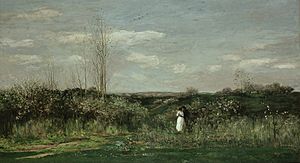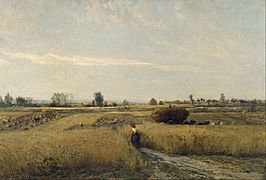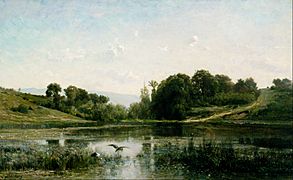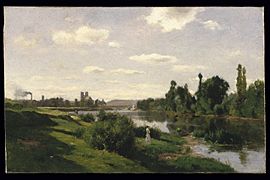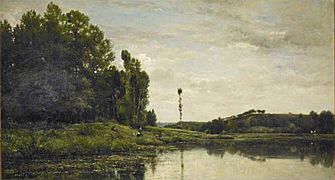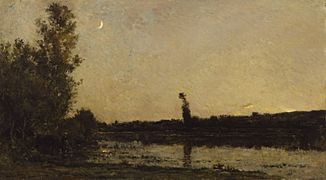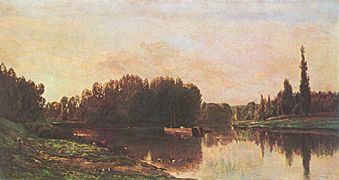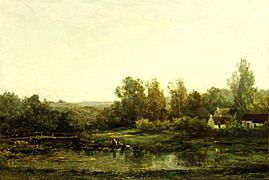Charles-François Daubigny facts for kids
Quick facts for kids
Charles-François Daubigny
|
|
|---|---|
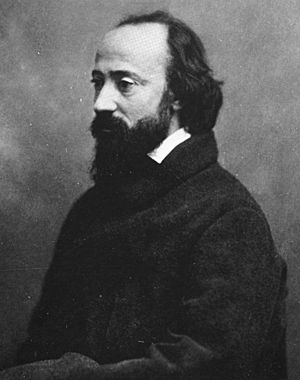
Photograph by Nadar
|
|
| Born | 15 February 1817 Paris, France
|
| Died | 19 February 1878 (aged 61) Paris, France
|
| Known for | Painting |
| Movement | Barbizon school |
Charles-François Daubigny (born February 15, 1817 – died February 19, 1878) was a French painter. He was a key member of the Barbizon school, a group of artists who painted landscapes. Many people also see him as an important artist who helped lead the way for impressionism.
Daubigny was also very good at making prints. He mostly used a technique called etching. He was also one of the main artists to use a special method called cliché verre, which is a mix of photography and printmaking.
Contents
About Charles-François Daubigny
Daubigny was born in Paris, France. His family was full of painters! His father, Edmé-François Daubigny, and his uncle, Pierre Daubigny, taught him how to paint. He also learned from other artists like Jean-Victor Bertin and Paul Delaroche.
In 1838, he started an art community in Paris with friends like Ernest Meissonnier. They were interested in painting everyday life and nature. These artists often worked for a publisher named Léon Curmer, who made books with small pictures. This is when Daubigny started making his first well-known engravings.
At first, Daubigny painted in a more traditional way. But this changed after 1843 when he moved to Barbizon. There, he started painting outdoors in nature. A very important moment was when he met Camille Corot in 1852.
Daubigny had a famous boat called Botin. He turned it into a floating art studio! He used this boat to paint along the Seine River and Oise River, especially near Auvers-sur-Oise. From 1852 onwards, he was also influenced by Gustave Courbet. Both artists were interested in painting things as they really looked, a style called realism. They even painted together in Optevoz.
In 1848, Daubigny made copies of famous artworks for the Louvre museum. This showed how skilled he was. His well-known series of Rolling Carts prints comes from this time. In 1862, he and Corot tried out the cliché-verre technique, which was a new way to make prints using glass and light.
In 1866, Daubigny joined the jury for the Paris Salon, which was a big art show. His friend Corot was also on the jury. In 1866, Daubigny visited England. He had to return in 1870 because of the Franco-Prussian War. In London, he met Claude Monet, who was a young Impressionist painter. They traveled to the Netherlands together. When Daubigny came back to Auvers, he met Paul Cézanne, another important Impressionist artist. It's believed that these younger Impressionist painters were inspired by Daubigny's work.
Charles-François Daubigny passed away in Paris in 1878. He is buried in the Père Lachaise Cemetery.
Many artists learned from Daubigny. These included his son, Karl Daubigny, whose paintings are sometimes mistaken for his father's. Other students were Hippolyte Camille Delpy and Albert Charpin. Two painters who brought the Barbizon School style to Portugal in 1879, António da Silva Porto and João Marques de Oliveira, also studied with him.
Daubigny's Paintings
The most famous paintings by Daubigny were made between 1864 and 1874. These often showed forest scenes and lakes. Even though he sometimes felt he wasn't as famous as other artists, he was actually very popular and admired by the end of his life. His paintings often showed wide landscapes with light coming from behind, a style that influenced his student Hippolyte Camille Delpy.
Some of his most important paintings include Springtime (1857), which is in the Louvre museum, Villerville sur Mer (1864), and Return of the Flock (1878). The French government honored him by making him an Officer of the Legion of Honor.
Where to See Daubigny's Art
You can find paintings by Charles-François Daubigny in many public art collections around the world, such as:
- The Art Institute of Chicago
- Cincinnati Art Museum
- The Frick Collection, New York
- The Hermitage, Saint Petersburg
- Mesdag Collectie, The Hague
- The Israel Museum, Jerusalem
- Kunstmuseum Den Haag, The Hague
- Metropolitan Museum of Art, New York
- Montreal Museum of Fine Arts
- Musée du Louvre, Paris
- Musée d'Orsay, Paris
- Museum de Fundatie, Zwolle
- Museum of Fine Arts, Boston
- National Gallery of Canada, Ottawa
- National Galleries of Scotland, Edinburgh
- National Gallery, London
- National Gallery of Art, Washington, D.C.
- Neue Pinakothek, Munich
- Rijksmuseum, Amsterdam
- Smithsonian American Art Museum, Washington, D.C.
Gallery
-
Harvest (1851)
Musée d'Orsay, Paris -
The Ponds of Gylieu (1853)
Cincinnati Art Museum -
The River Seine at Mantes (1856)
Brooklyn Museum -
Banks of the Oise (1863)
Saint Louis Art Museum -
Twilight (1866)
Walters Art Museum, Baltimore -
La Confluence de la Seine et de l'Oise (1868)
Museum of Fine Arts, Budapest -
Les Blanchisseuses (1870-1874)
The Frick Collection, New York -
Les Sables-d'Olonne, seaside town
in western France -
Boats on the Seacoast at Étaples (1871)
Metropolitan Museum of Art, New York -
Les Laveuses (1873)
Aberdeen Art Gallery -
Lever de lune à Auvers, or Le Retour du troupeau (1878)
Montreal Museum of Fine Arts -
Farm at Kerity, Brittany
Kunstmuseum Den Haag, The Hague
See also
 In Spanish: Charles-François Daubigny para niños
In Spanish: Charles-François Daubigny para niños
- Daubigny's Garden, painted three times by Vincent van Gogh.


